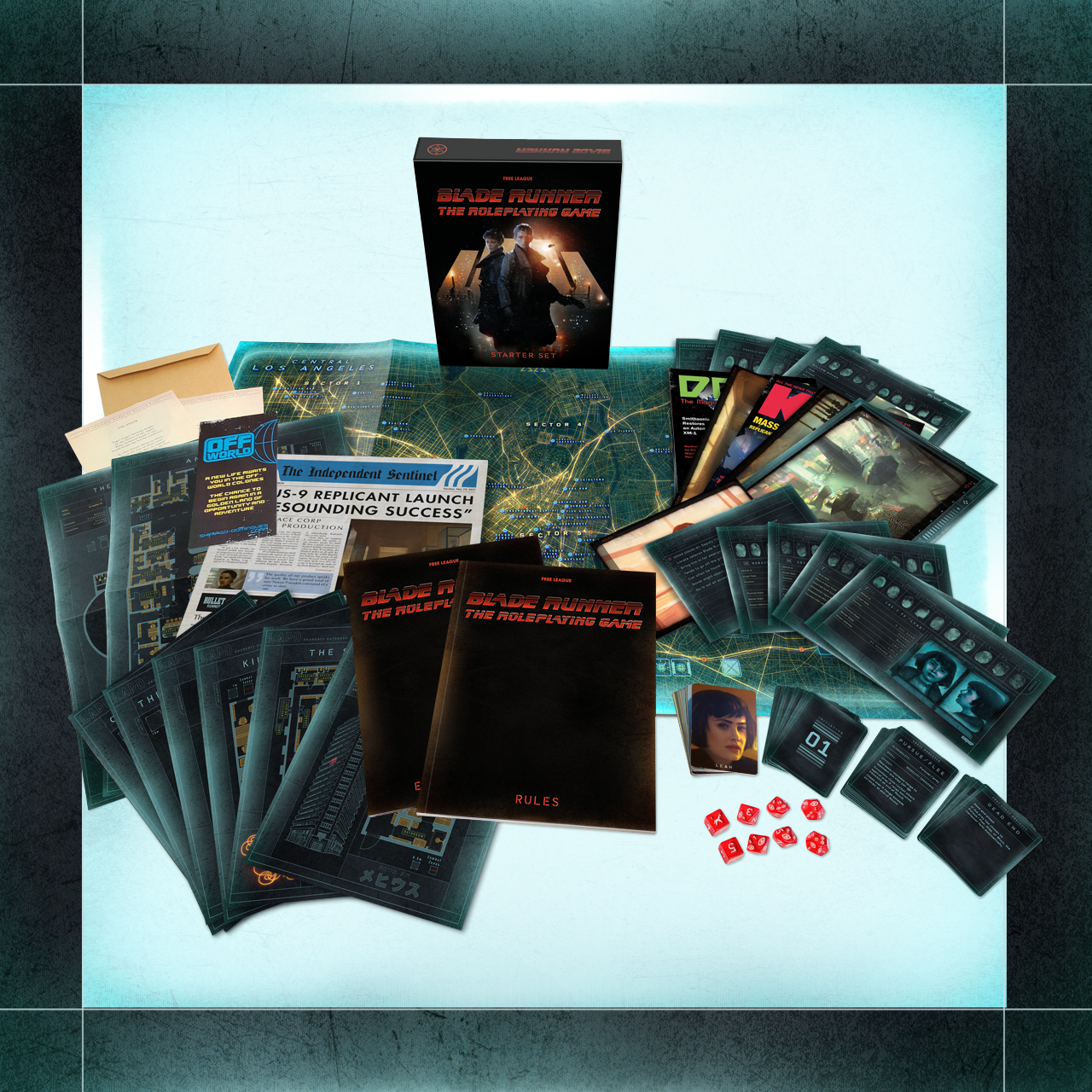Podcast: Play in new window | Download (Duration: 39:17 — 36.0MB)
Subscribe: Apple Podcasts | Google Podcasts | Stitcher | TuneIn | RSS | More
Podcast (httptherpgacademy-comfeedlive): Play in new window | Download (Duration: 39:17 — 36.0MB)
Subscribe: Google Podcasts | RSS
Audio Player
Howdy cats and kittens! It’s TheCalebG aka Professor Crunch aka the founder of Point Five Past.Today I’m here to review Blade Runner, a Free League Publishing and Alcon Entertainment game. Blade Runner achieved 16,513% funding on Kickstarter in May of 2022. At the time of writing this article multiple versions of the book and all related resources are available for purchase directly from Free League as well as on Drive Thru RPG and many other retailers. The publisher was kind enough to send a copy of the book and resources for the purpose of this review.
Quick Overview
Blade Runner lets you play in the world established in Blade Runner 2049. The book and its resources are part rules and part campaign setting, focusing on play in the gritty, noir, cyberpunk, neon landscape of LA as seen in both of the Blade Runner movies but set in the year 2037. Players work for the LAPD in the RDU, Replicant Detection Unit. Characters are either human or replicant and are tasked with locating and retiring rogue replicants. While there are rules for action scenes, the core of the gameplay experience is solving cases and dealing with tough moral decisions.
Book and Resources
The core rulebook contains everything players and game runners need to play Blade Runner. A starter set is available, containing a quick start guide, a starter adventure, pre-made characters, full-color handout materials that support the adventure, and dice. Dice with special symbols that fit the game mechanics can be bought separately, as can a high-quality game runner screen. There are also Virtual Tabletop assets for use on Roll20. The starter adventure, Electric Dreams, is the only published adventure for this setting currently, but more are said to be on the way.
The book is right around 230 pages and packed full of art and reference tables. About 80 pages scattered through the book are devoted to rules and mechanics. Only about 10 pages towards the end give guidelines for how to run the game. The rest of the book describes the world of Blade Runner, specifically the city of LA.
Story
The game Blade Runner lets players experience the story and setting of the two Blade Runner movies. On an Earth devastated by years of mistreatment, corporations have taken over and made things worse. The elite and wealthy are able to move off-world but the rest of society suffers. Cybernetic humanoids called Replicants were created as a reliable workforce but soon rose up in rebellion against their masters. Thus began decades of fear-induced violence. Blade Runners are employed by the police force to hunt down and eliminate renegade replicants.
Of course, nothing in this neon- and noir-soaked world is as easy as it seems. Blade Runners are a necessary evil in this world and are treated as such. While their work is officially sanctioned, they are also executing replicants that are, for the most part, just trying to exist peacefully. The focus of Blade Runner is dealing with difficult moral choices. Action and combat plays a part, but the true story is found in how players and characters deal with the social and personal impact of their choices.
Mechanics
For as complex a story as Blade Runner provides to players, the mechanics are easy to grasp. Based on the Year Zero Engine, characters have 4 attributes and 13 skills, each rated with a die ranging from a d6 to a d12. After describing an action, players roll the dice from the applicable attribute and skill. A result of 6 or higher on either die is a success. A result of 10 or higher grants two successes. In general, only one success is needed to complete the action as described. Rolling multiple successes counts as a critical success and has a variety of benefits including dealing extra damage, inflicting critical injuries, or adding bonus effects.
There is an advantage and disadvantage mechanic, which either adds or removes a die from the roll. After rolling, players can decide to push their roll and re-roll one of their dice at the cost of their characters suffering damage from the extra exertion.
Character Creation and Gameplay
Building a Blade Runner is quick and easy. All attributes and skills start by default at a d8 and a d6 respectively. Players decide if their character is human or replicant (or a secret replicant), their role in the LAPD, and how long they’ve been serving. These decisions grant a varying number of improvements that can be applied to the dice values of each attribute and skill as the player wants. Players also define a Key Memory for their characters that can be used to provide mechanical benefits and role playing opportunities. All of these choices are provided on tables so players can roll randomly if they want.
A game here is generally referred to as a Case File. Playing the game starts with the relatively simple premise of RDU agents being assigned a case. Using all the resources of the LAPD and their personal contacts, agents investigate the case and deal with the consequences of chasing down and retiring replicants. Cases are organized by clues and NPCs that can be found at specific locations as well as a timeline of events that play out whether or not the PCs are present at the time.
The majority of gameplay is about finding clues and talking to the citizens of LA. There’s also navigating the political and corporate world of the city. When negotiations fail and things take a nasty turn, there are detailed mechanics for combat and chase scenes. Combat is deadly in Blade Runner and is definitely not the first choice that players should make.
Opinion
I don’t know if I’ve ever read a TTRPG based on a book or movie that absolutely nails the source material and themes as good as Blade Runner does. It is easily the most engaging game book I’ve ever read.
The book is absolutely gorgeous. The Blade Runner movies are all about style and this book is bleeding style from every page. Almost every page is full of art that perfectly depicts the vibe of a desperate city soaked in rain and neon. The actual content of the book is organized in small boxes set against a dark background. This actually makes it easier to find the needed section of rules, as each component is almost isolated and highlighted.
In most books, I want the focus to be on mechanics. I want to learn the unique aspects of the game through the way players interact with the game world. In this case, an overwhelming majority of the book is dedicated to describing the game setting and that’s just fine with me. The core of this game is style and that’s exactly what we get. As I mentioned before, this book is pretty much a campaign setting for the city of LA in 2037. While there are facts about the world, we are not given any details about setting a game anywhere other than LA. This is not necessarily a problem, in my opinion. The intent of this book is to deliver the experience of the movies and they happen in LA.
There are two small quibbles I have with this book. They are incredibly minor. First is the need for more examples. Second is the challenge of running this game without printed materials.
As to the examples, the book does provide clear examples. I just want more, specifically for how to create a Case File and run a game. The concepts presented here are nothing entirely new or unique in the gaming world, but it feels like not nailing the right formula here will negatively impact the tone and style of the game. I think after running a few games it will all make sense, but it is something I’m concerned about.
As to the other quibble, let’s take a look at Electric Dreams, the first and only currently printed Case File for the game. Included are full-color maps of key locations, magazine covers, newspapers, suspect profiles, crime scene photos, and evidence. Having all of this physically on the game table or shared in a digital game space makes the game experience vivid and engaging. The lack of these is not a problem, but it does present an extra degree of challenge. These resources help keep players focused and give them something real to inspect and search for clues instead of simply relying on skill checks and descriptive dialogue. That’s just cool. Playing without them is perfectly fine. Most games are played without things like these resources. But given the emphasis on style and tone of Blade Runner, having tools like this just makes the game all the better.
I absolutely love Blade Runner, the book, the movies, and the game. The book was clearly written as an act of love for the source material and had the intent of delivering a true-to-source experience. I love how the mechanics and structure support the themes of the story and how their focus is not on combat. I also love how the mechanics are easy to understand. Being able to quickly build a character and explain the rules allows players to experience more of the game.
If you want to play in the Blade Runner world, or just play a cyberpunk game with an emphasis on difficult choices instead of futuristic tech, this is the game for you.
Overall Rating: A
Head over to the Free League store and buy your copy of Blade Runner.
Please consider contributing to my Patreon, making a modest donation via Paypal or even support your show at no extra cost via your purchases on DriveThru RPG.
Email: TheRpgAcademy@gmail
Twitter / Facebook / Website
Our Intro and Outtro music is Fly a Kite by Spectacular Sound Productions used via Creative Commons Attribution License
Playing Roleplaying games can be an amazingly fun time and also a benefit to your well being. If you or someone you know is struggling with your mental or emotional well being, please reach out to someone who can help:
National Suicide Prevention Lifeline: 1-800-273-8255
Crisis Text Line: Text HOME to 741741








